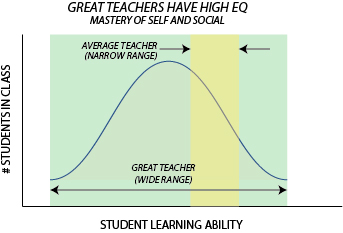Stanford Report: Stanford’s Gardner Center partners with California schools on new reform plan
Thursday, January 30th, 2014The January 29, 2014 Stanford Report carried an article titled “Stanford’s Gardner Center partners with California schools on new reform plan” by Brooke Donald. Mention of “social and emotional learning” in the by-line was the grab for me. I certainly agree that coaching social and emotional intelligence in school is a commendable thing to do. Whether this would lead to academic performance parity would seem uncertain but a place in an accountability system seems appropriate. Remember too that the education time-scale is finite as is the student attention span, so any shift in school-time use will cause something from the memorization end to fall out. It’s a law of conservation.
In light of my recent article on Teacher EQ, it seems a better and more productive place to start is to coach educators on developing their own EQ. The questions that I think need to be answered first is whether educators empathize with students and whether when they are introduced to a new class of students they have their EQ-expectation calibrated with the range of EQ among the students. An EQ-mismatch generally spells disconnect with the students and stress/strain.
The YCISL message is to equip educators with EQ-enhancement tools for personal development as well as classroom application. Adopt curriculum which support EQ-development (most textbooks are light on EQ; standardized tests too) and give educators a more intrinsically motivating teaching goal than test scores.
There’s no secret. If you’re in the classroom, your EQ needs to be developed just as much as the next person’s whether teacher, student or administrator. How do you do that? Try teaching or learning outside your comfort zone and daily routine – choose something that you feel you might be good at but may not have done in quite some time – ASL, Music, Drama, Woodworking, Customer Service… It’s like that experiment where company executives switch roles with front line personnel for a day (e.g., CEO<->receptionist). As a thought experiment for teachers and school administrators, insert into your schedule a quiz or test every couple of days for every one of your key functions. What does this do to your thought process and workflow? Also, memorize all the work you have to do the next day during the night before. If you have a meeting, memorize the agenda and any PowerPoint that will be shown. Do you think you will forget 90% of that total material after the meeting? Welcome to the student’s world. Feeling any EQ now?
To tie in a positive thinking note, students: be able to recognize teachers who demonstrate high EQ and show them respect for that. Know that high EQ teachers are worthy role models and that they can help you build, define and refine your EQ. This will give you the answer to why you are learning and what you will gain from it.





